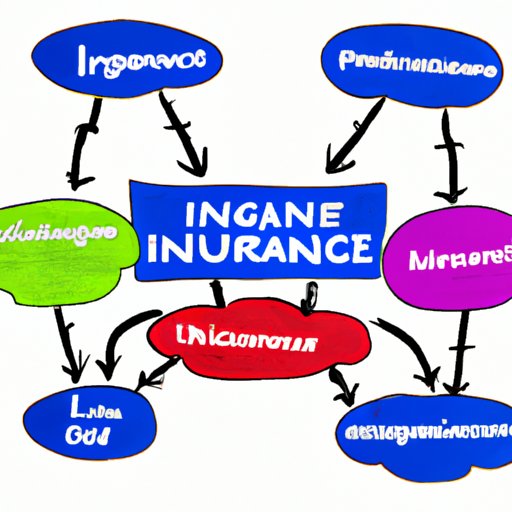Introduction
Insurance is a way to manage risk by transferring it to an insurer. The cost of insurance is determined by the amount of risk associated with the policy, as well as other factors such as age, gender and credit score. In this article, we’ll explore how much insurance costs, the different types of insurance available and the factors that impact insurance premiums.
Comparing Average Insurance Costs by State
To get an idea of how much insurance costs on average, researchers at Insurify gathered data from over 2 million auto insurance quotes across all 50 states and the District of Columbia in 2020. They found that the average annual premium for auto insurance in the U.S. was $1,922, with an average monthly premium of $160. However, there were wide variations in the average cost of insurance by state, ranging from a low of $1,118 in Maine to a high of $3,104 in Michigan.

Understanding the Different Types of Insurance and Their Costs
There are many different types of insurance available, and the cost of each type can vary significantly. Let’s take a look at some of the most common types of insurance and their associated costs.
Car Insurance
Car insurance is typically the most expensive type of insurance. According to the National Association of Insurance Commissioners, the average cost of car insurance in 2019 was $1,555 per year or $129 per month. However, this number can vary significantly depending on the coverage you choose, your driving record and other factors.
Homeowners/Renters Insurance
Homeowners or renters insurance provides financial protection against disasters or theft. The average cost of homeowners insurance in 2019 was $1,211 per year, or $101 per month, according to the Insurance Information Institute. Renters insurance is generally less expensive than homeowners insurance, averaging around $180 per year or $15 per month.
Health Insurance
Health insurance helps cover the cost of medical care and can help protect you from high medical bills. According to the Centers for Medicare & Medicaid Services, the average annual premium for employer-sponsored health insurance in 2020 was $7,470 for single coverage and $21,342 for family coverage. However, the actual cost of health insurance can vary significantly depending on where you live, your age, your income and other factors.
Life Insurance
Life insurance provides financial support to your loved ones in the event of your death. The cost of life insurance depends on a variety of factors, including your age, health and lifestyle. According to the Life Insurance Marketing and Research Association, the average cost of a 20-year term life insurance policy for a 40-year-old male in good health is $47 per month.

Examining Factors that Impact Insurance Costs
In addition to the type of insurance you purchase, there are several other factors that can influence the cost of your insurance premiums. These include:
Age
Your age is one of the most important factors in determining your insurance premiums. Generally, younger drivers pay higher premiums than older drivers due to their lack of experience and greater risk of being involved in an accident.
Gender
Gender is another factor that can affect your insurance premiums. Studies have shown that men tend to pay higher premiums than women, as they are statistically more likely to be involved in an accident.
Location
The area in which you live can also affect your insurance premiums. This is because certain areas are more prone to certain risks, such as flooding or earthquakes. As a result, living in an area with higher risks could mean higher insurance premiums.
Credit Score
Your credit score can also have an impact on your insurance premiums. Insurance companies view people with good credit scores as less of a risk than those with poor credit scores, so having a good credit score can result in lower insurance premiums.
Driving Record
Your driving record is another key factor in determining your insurance premiums. Drivers with a history of traffic violations or accidents will typically pay higher premiums than those with a clean driving record.
Exploring How Insurance Premiums are Calculated
Insurance companies use a variety of methods to determine the cost of an insurance policy. The two main methods used are risk assessment and actuarial tables.
Risk Assessment
Risk assessment involves assessing the risk associated with a particular policyholder. Insurance companies use a variety of factors to assess risk, such as age, gender, driving record, credit score and location. The higher the risk, the higher the insurance premiums.
Actuarial Tables
Actuarial tables are mathematical models used to predict the likelihood of a claim being made on a policy. Insurance companies use these tables to calculate the expected costs associated with a particular policy, and then set premiums accordingly.

Researching Ways to Lower Your Insurance Costs
There are several ways you can lower your insurance costs. Here are a few tips to keep in mind when shopping for insurance:
Shopping Around for Quotes
One of the best ways to save on insurance is to shop around for quotes. Comparing quotes from multiple insurance companies can help you find the best deal.
Bundling Policies
Many insurance companies offer discounts if you bundle multiple policies, such as car and home insurance. Bundling policies can help you save money on your premiums.
Raising Deductibles
Raising your deductibles is another way to save on your insurance premiums. A higher deductible means you’ll pay more out of pocket for a claim, but it can also result in lower insurance premiums.
Investigating Common Insurance Discounts
Insurance companies often offer discounts to encourage customers to purchase insurance. Some common discounts include:
Good Student Discounts
Many insurance companies offer discounts for students who maintain a certain grade point average. This can help students save money on their insurance premiums.
Multi-Policy Discounts
Insurance companies often offer discounts to customers who purchase multiple policies, such as car and home insurance. This can help you save money on your premiums.
Defensive Driver Discounts
Some insurance companies offer discounts to drivers who take defensive driving courses. Taking a defensive driving course can help you save money on your insurance premiums.
Paying Annually
Many insurance companies offer discounts for customers who pay their premiums annually instead of monthly. Paying annually can help you save money on your insurance premiums.
Conclusion
In conclusion, insurance is an important way to manage risk and protect yourself financially. The cost of insurance can vary significantly depending on the type of insurance you purchase, as well as other factors such as age, gender, location and credit score. Shopping around for quotes, bundling policies and raising deductibles are all ways to save money on your insurance premiums. Finally, don’t forget to ask about discounts that may be available.
Summary of Key Points
This article explored the average cost of various types of insurance across the U.S., examined factors that impact insurance premiums and offered tips for finding ways to lower your insurance costs. We found that the average annual premium for auto insurance in the U.S. was $1,922, with an average monthly premium of $160. Other types of insurance, such as homeowners, renters, health and life insurance, cost an average of $1,211, $180, $7,470 and $47 per month respectively. Additionally, factors such as age, gender, location, credit score and driving record can all have an impact on your insurance premiums. Finally, there are several ways to save money on your insurance, such as shopping around for quotes, bundling policies and taking advantage of discounts.
Final Thoughts on Insurance Costs
Insurance is an important way to manage risk and protect yourself financially. It’s important to understand the different types of insurance available, as well as the factors that can affect your insurance premiums. By understanding these factors and researching ways to save money on your insurance, you can make sure you’re getting the best possible deal on your insurance.
(Note: Is this article not meeting your expectations? Do you have knowledge or insights to share? Unlock new opportunities and expand your reach by joining our authors team. Click Registration to join us and share your expertise with our readers.)
